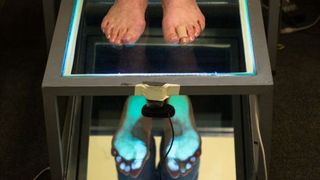What Are Custom Insoles And How Can They Help Runners?
Niggles cramping your running style? Orthoses can be a vital ally in the running battle against injuries

As with most things in life, treating running injuries isn’t straightforward and things can get complicated quickly. That’s especially true when fellow runners and Dr Google are throwing suggestions at you left, right and centre. One of those suggestions may well be custom insoles (aka orthoses) but if you Google that term, as we did, a whole load of information is flung at you from a wide variety of sources. So to make things clearer, we spoke to Alex Ross, specialist sports podiatrist at Pure Sports Medicine, for all the info you need on custom insoles.
What are custom insoles?
When you look online you see many different types. Podiatrists use customised foot orthoses. They’re designed from an impression or mould of the person’s foot.
Are orthoses different to custom insoles?
The official name for what podiatrists offer is customised foot orthoses. A lot of the “custom” insoles you get online are a standard shape or insole, which is then heat-moulded and adapted. We tend to call them semi-customised orthoses.
What problems can they help with for runners?
The way orthoses work is by altering the load, the forces, going through the foot. Traditionally, people used to think it was by correcting the foot – making it straight, making it roll in less. We know now that’s not how they provide their benefit.
A lot of running injuries are slow, repetitive injuries, like plantar heel pain, or runner’s knee or patellofemoral joint pain. If, for example, your tibialis posterior tendon is irritated – so it’s sore to walk – we can use an orthotic device to reduce how hard it has to work. We’re trying to even out how much it can tolerate, while sorting out the strength in it.
Are they only of use for runners with injury problems?
I tend mostly to see people who have injuries, and even then when you come to a podiatrist not everyone gets an insole device.
If you came to me for a gait analysis and a running assessment, and you’re nice and strong and achieving everything without symptoms of injury, I wouldn’t give you an orthotic device. It might help you reduce load in one place, but as a consequence you’ll increase load somewhere else. When you help in one area, you have to make sure the other area can take the increase in stress.
Get the Coach Newsletter
Sign up for workout ideas, training advice, reviews of the latest gear and more.
See related
- An Expert Explains How To Prevent And Treat Achilles Tendonitis
- Plantar Fasciitis: How To Spot, Treat And Prevent This Runner’s Nightmare
- Five Exercises To Minimise The Risk Of Shin Splints
What are the key differences between the insoles you get from a chemist, from a foot scan at a running store, and from a full assessment with a podiatrist?
From the chemist you’ll get gel insoles with a standard kind of shape. These are trying to make it so more people find it comfortable to walk or run, which for some people is fantastic and for some people it’s aggravating.
From the running store with the foot scan it’s a static assessment. If [a custom insole is being introduced] just because people look like they roll in a bit, that’s going to be problematic, because one person can find that insole fantastic and feel it’s really comfortable, but someone with a foot that appears to do the same thing can absolutely hate it.
From a podiatry point of view its not about trying to correct the foot, because there’s no such thing as “normal” in a foot position or in the way we should move. We all have our different individual movement patterns.
It’s on a case-by-case basis. What’s sore? Why is it sore? What job does that sore muscle or tendon do? And then, how can we help that muscle or tendon do its job?

Nick Harris-Fry is a journalist who has been covering health and fitness since 2015. Nick is an avid runner, covering 70-110km a week, which gives him ample opportunity to test a wide range of running shoes and running gear. He is also the chief tester for fitness trackers and running watches, treadmills and exercise bikes, and workout headphones.
